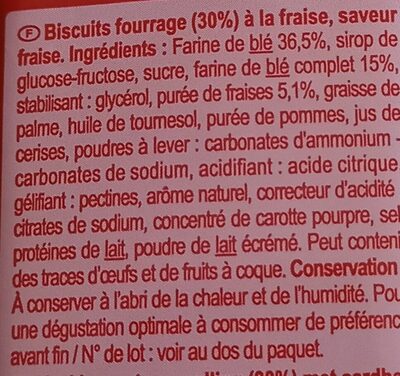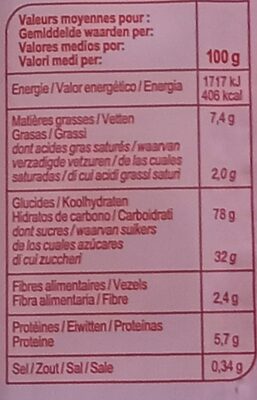Tóòns goût fraise🍓 - Carrefour - 295 g
This product page is not complete. You can help to complete it by editing it and adding more data from the photos we have, or by taking more photos using the app for Android or iPhone/iPad. Thank you!
×
Some of the data for this product has been provided directly by the manufacturer Carrefour.
Barcode: 3560071179267 (EAN / EAN-13)
Common name: Biscuits fourrage (30%) à la fraise, saveur fraise.
Quantity: 295 g
Packaging: Paquet de 16 gâteaux
Brands: Carrefour
Categories: Snacks, Sweet snacks, Biscuits and cakes, Biscuits, Filled biscuits, Strawberry biscuits
Labels, certifications, awards: Nutriscore, Fabriqué en France, Point Vert
Traceability code: EMB 82121 - Montauban (Tarn-et-Garonne, France)
Stores: Carrefour, carrefour.fr
Matching with your preferences
Other information
Conservation conditions: À conserver à l'abri de la chaleur et de l'humidité. Pour une dégustation optimale, à consommer de préférence avant fin / N° de lot : voir au dos du paquet.
Customer service: Interdis - TSA 91431 - 91343 MASSY Cedex - France.
Report a problem
Data sources
Product added on by kiliweb
Last edit of product page on by dorado.
Product page also edited by additives-app-chakib, date-limite-app, driveoff, ecoscore-impact-estimator, musarana, off.b9cabf19-1626-4cc6-b1da-14289ca65273, openfoodfacts-contributors, org-carrefour, packbot, pauliano, phyl49, quechoisir, roboto-app, spotter, teolemon, thaialagata, tofteuf, yuka.ZUpBaUFJUWxpK1V5aS9NSHBFdmw0L1J2M3BhdFExS3NDdkE5SUE9PQ, yuka.sY2b0xO6T85zoF3NwEKvlm98VILhgBLBFxr4wxS22dO-NqDaPfJ109fdI6g, yuka.sY2b0xO6T85zoF3NwEKvlmFbXfD-hxXKJ0bThE6tmtSDH6DDb_Z23Ieiaao.












